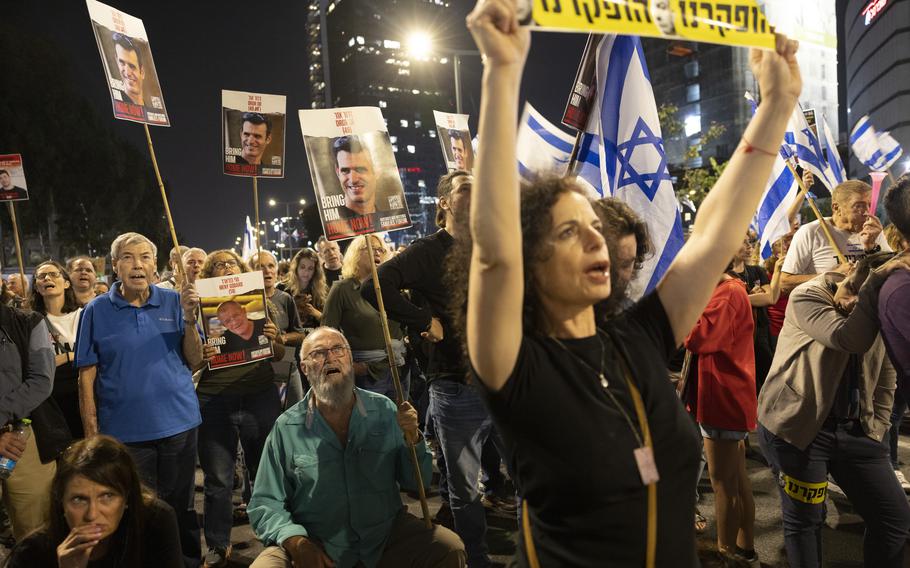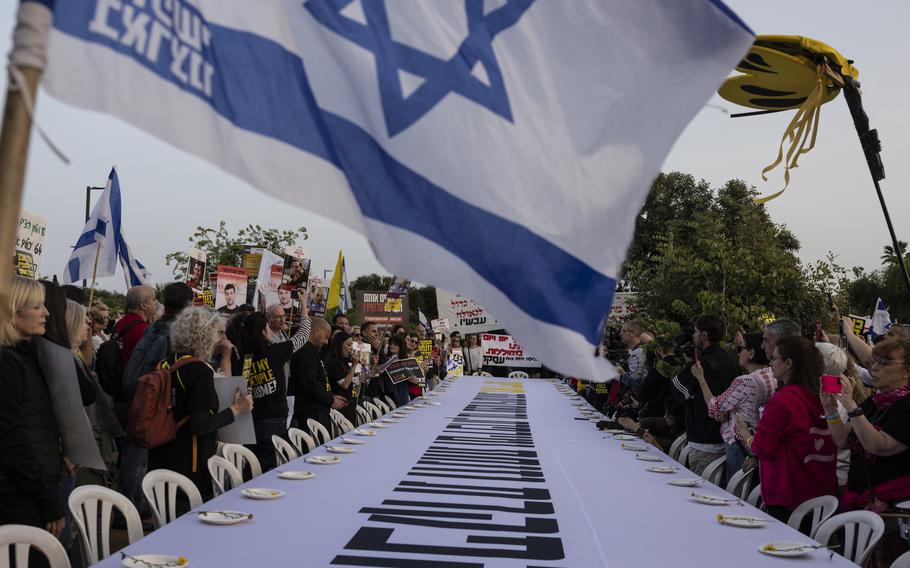Middle East
Amid Passover, both sides eye resumption of wider war in Gaza
The Washington Post April 24, 2024

Yuval Or, 72, the father of hostage of Dror Or, sits on a folding chair in the middle of the road during an anti-government protest Saturday, April 20, 2024, in Tel Aviv. (Heidi Levine/for The Washington Post)
JERUSALEM — Israelis marked a somber Passover this week, breathing easier after an ominous military escalation eased with Iran but bracing themselves amid growing signs Israel is preparing the next phase of its war in Gaza: a final fraught assault on Rafah, the packed city where Hamas’ remaining fighters are holding Israeli hostages and more than a million civilians are sheltering.
Gazans reported an increase in Israeli raids and shelling, and the Israeli military said Wednesday that it had struck more than 50 targets in the last 24 hours. It also called up two reserve brigades for both “offensive and defensive” missions inside Gaza.
World Food Program officials warned again of impending starvation in Gaza, particularly in the north. But the United Nations also offered a rare optimistic accounting of humanitarian aid shipments, saying a recent surge of deliveries has boosted the number of food trucks entering Gaza to the highest levels since the start of the war.
Some analysts see both the increased military activity and the humanitarian blitz, as well as signs of new tent cities in central Gaza, as precursors to an invasion of Rafah.
The Biden administration, which has pushed Israel for months to increase the delivery of aid, has warned the government it would not support a Rafah operation that fails to provide greater protection for the civilian refugees there.
“The focus is back in Gaza, and everybody is waiting for the next move,” said Abdulkhaleq Abdulla, an Emirati academic.
David Mencer, a spokesperson in the office of Prime Minister Benjamin Netanyahu, confirmed Wednesday that “Israel is moving ahead with our operation to target Hamas in Rafah. We will, as usual, be making every effort to move civilians out of harm’s way.”
Families of the Israelis still held hostage observed Passover with vacant chairs at their Seder meals. Hundreds came out late Monday to protest Netanyahu, whom they blame for failing to reach a temporary cease-fire and a deal to release the hostages, leaving the captives in Hamas’ hands and in harm’s way for any attack on Rafah.
Militants kidnapped 253 people in the Oct. 7 surprise attack that also killed about 1,200 Israelis. A negotiated pause in the fighting in November coincided with the release of 105 Israeli hostages and foreign nationals in exchange for 240 Palestinian prisoners held in Israeli jails.
An unknown number remain alive. Hamas released on Wednesday a new video showing American Israeli hostage Hersh Goldberg-Polin, one of the most-discussed captives, who was last seen being taken from the Nova music festival after his left hand had been blown off. The anguished video is the first public evidence that he is alive. The Hostages Families Forum issued a statement on behalf of his family saying, “Hersh’s cry is the collective cry of all the hostages — their time is rapidly running out.”

Families of Israeli hostages protest in front of Israeli Prime Minister Benjamin Netanyahu’s home on the eve of Passover in Caesarea, Israel, on Tuesday, April 23, 2024. (Heidi Levine/for The Washington Post)
Enraged hostage advocates burned a symbolic Seder table near the prime minister’s home in Caesarea, according to local media. Others said they had worked their anger at the prime minister into their reflections on biblical hardships.
“Egypt got 10 plagues,” Maya Raviv said at a protest over the weekend, referring to the story of Exodus, retold each year on Passover, “and Israel got one. It’s called Bibi Netanyahu.”
Negotiations for a deal being brokered by the United States, Qatar and Egypt have stalled, and the world’s attention in recent weeks largely swung away from Gaza toward a burgeoning escalation between Israel and Iran.
The two exchanged air attacks, prompting fears that a regional war could erupt. Iran’s barrage of more than 300 missiles and attack drones marked an unprecedented direct attack from Iranian to Israeli soil. But a pop-up coalition including U.S., European and Jordanian forces combined with Israel’s air defense system to down more than 99 percent of the munitions.
After Israel responded with a limited attack that reportedly damaged an Iranian air defense unit but caused no fatalities, both sides seemed ready to stand down. Attention has now swung back to Gaza, leaving many observers to predict that Israel will move to fulfill its promise of a final push sometime after the Passover holiday.
Israeli attacks have killed more than 34,000 Gazans since the war began, according to Palestinian health authorities, and the toll continues to rise.
The U.N. called Tuesday for an investigation into the discovery of alleged mass graves at Nasser Hospital in Khan Younis. The hospital had been the scene of heavy fighting since February before IDF forces pulled out in early April.
Gazan civil authorities said they found 238 bodies on the grounds over the weekend. They said the bodies were in various states of decomposition and some were in Israeli body bags.
The Israel Defense Forces said they did not bury the bodies, but had exhumed corpses in graves at the hospital grounds in a search for hostages. “The examination was carried out … respectfully while maintaining the dignity of the deceased,” the IDF said in a statement. “Bodies examined, which did not belong to Israeli hostages, were returned to their place.”
Israel says it has to go into Rafah to finish its fight against Hamas. But preparation for that push come as aid groups, and many of Israel’s allies, warn of a worsening humanitarian crisis for Gazan civilians.
“We are getting closer by the day to a famine situation,” said Gian Carlo Cirri, Geneva director of the World Food Program, adding that Gazans could be six weeks from crossing three critical famine thresholds — food insecurity, malnutrition and mortality.
But United Nations leaders said a recent surge of humanitarian deliveries gave them some hope that famine could be averted. Philippe Lazzarini, the head of the main U.N. aid agency for Palestinian refugees, said more than 310 aid trucks entered Gaza on Monday — some of them crossing at newly opened gateways from Israel — the highest number since Oct. 7.
“It needs now to be sustained & further increased,” Lazzarini said in a post on X. “Famine in northern Gaza can be averted only through meaningful & uninterrupted supply.”
Gazan civilians said they fear that any improvements in the food supply could be wiped out by the return of intense military operations in the northern and central sections of the enclave.
More flour and other rations have been available in recent days, according to Anwar Rabhi, 51, who has been taking his family of seven children from one shelter to another since their home near Beit Lahia was destroyed early in the war. After shelling picked up on Tuesday, they fled once again.
“This may be the 20th time that I have moved from one place to another,” Rabhi told The Washington Post in a phone interview. “Here we are moving, and we do not know whether we will survive this wave or not.”
Loveday Morris in Berlin, Heidi Levin in Tel Aviv and Hazem Balousha in Cairo contributed to this report.